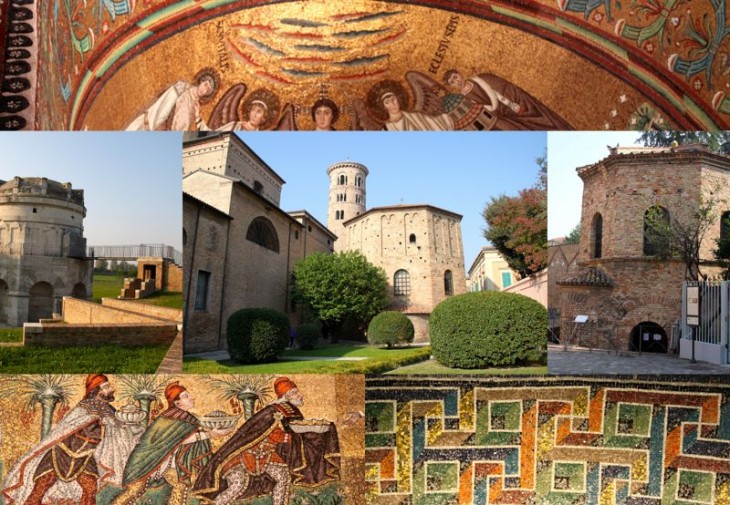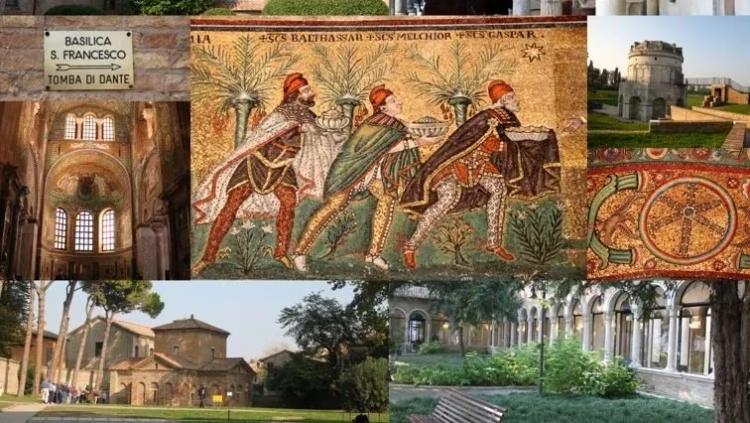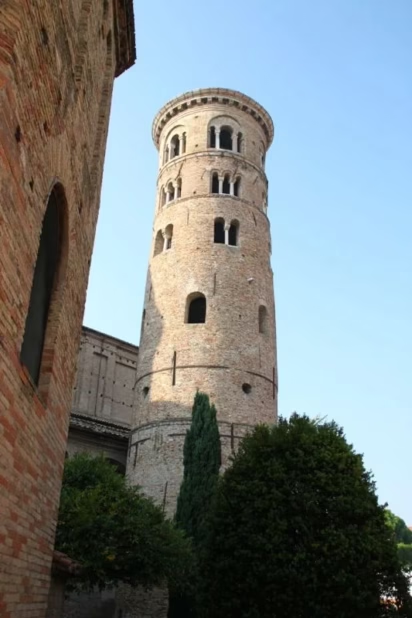Ravenna is famous for its Late Antiquity and Byzantine wall and ceiling mosaics in early Christian monuments and churches, which are the top sights to see when visiting this interesting town. Ravenna is a popular day-trip destination from Bologna and Rimini, as well as shore excursions for luxury passenger boats calling in Venice, Italy.
Ravenna, a small city with a glorious past, is quietly located on the Adriatic Sea in northeastern Italy. Ravenna’s most popular sights are UNESCO World Cultural Heritage-listed monuments and mosaics dating from the fifth and sixth centuries when the town served as the capital of the (Western) Roman Empire. Ravenna has eight sites on the heritage list, each with some of the best Late Antiquity or Byzantine mosaics in existence. Further sights in Ravenna include Dante’s tomb, a lovely old town, museums, medieval defenses, and pleasant restaurants, but the wall mosaics really are what make Ravenna so special. Many guided tours are available, but the UNESCO-listed sites are also easily explored with entry ticket passes sold online.
A Brief History of Ravenna in Italy
Humans settled in Ravenna from the sixth century BC onwards but the glory years of Ravenna were a millennium later in the fifth and sixth centuries AD. The top sights are from this period.
With the (Western) Roman Empire in terminal decline, the capital was shifted from Rome to Milan and in 401 to Ravenna. Ravenna was probably chosen for its hard-to-attack location in the marshes, yet close to the port of Classe, the second largest naval base of the Roman Empire. Despite this favorable position, Ravenna still found itself sacked a few times by barbarian tribes.
As the capital city, Ravenna experienced several waves of major building activity. One of the most important periods was from 421 to 437, when Galla Placidia ruled the empire as regent for her son, Emperor Valentinian III. She had numerous buildings erected, including (probably) a mausoleum for herself, which is one of the highlights of any visit to Ravenna.
A second golden age was after the fall of the Roman Empire in 476 during the reign of the Ostrogoth King Theodoric the Great (474 – 526). He also constructed numerous monumental buildings – later several were destroyed or altered to hide the Arian beliefs of the Ostrogoths, which conflicted with the orthodox views of the Roman Catholic Church.

Ravenna had another brief golden moment after Emperor Justinian the Great (527 – 565) reconquered parts of Italy for the East Roman Empire. Ravenna was the foothold of the Byzantine (East Roman) Empire for about two centuries but would not recover its former capital status.
In the early Middle Ages, Ravenna became part of Lombardy. Although the city remained important well into the second millennium, the main reason to visit is to see the monuments from the pre-medieval period.
Top UNESCO-Listed Sites and Mosaics in Ravenna

Eight sites from the fifth and sixth centuries have been inscribed on the UNESCO World Cultural Heritage list as superb examples of early Christian monuments and wall mosaics from the late antiquity period.
These eight top sights to see in Ravenna are:
- The Archbishop’s Chapel – the oldest surviving private Christian oratory.
- The Neonian Baptistery – the oldest octagonal monument in Ravenna.
- The Arian Baptistery – with a mosaic-covered dome.
- The Basilica of Sant’Apollinare Nuovo – some of the largest and finest mosaics in Ravenna.
- The Church of San Vitale – a wonderful oriental-style church with important Justinian mosaics, considered the largest and best outside Istanbul.
- The Mausoleum of Galla Placidia – the oldest mosaics and often considered artistically the best in Ravenna.
- The Mausoleum of Theodoric – the only surviving tomb of a “barbarian” king from the late antiquity period.
- The Basilica of Sant’Apollinare in Classe – the largest church in Ravenna from the Late Antiquity period. (It is to the south of the city.)
For more details see also:
- Top Mosaics and Early Christian Monuments in Ravenna.
- Visiting UNESCO-Listed Churches and Mosaics in Ravenna (opening hours & ticket options).
- Book guided tours — typically three hours.
Other Top Sights to See in Ravenna

The magnificent Byzantine mosaics in Ravenna are so famous (with reason) that many of the other sights in this pleasant town are often overlooked, especially as many visitors are on day trips or rushed shore excursions from Venice.
In many other towns, some of these sights may be the main reason to visit but in Ravenna, they simply have to come after the mosaics when prioritizing. Even the large Baroque cathedral fails to make much of an impact.

Probably the most famous non-UNESCO-listed sight in Ravenna is Dante’s tomb. Dante Alighieri fled from Florence and spent the last few years of his life in Ravenna. His funeral service in 1321 was in the adjacent St Francis Basilica with his tomb on the northern side outside the church. The adjacent Dante Center is also worth visiting, even if only for the lovely view of St Francis from the cloisters. His cenotaph in Santa Croce in Florence remains empty.
It is also worth peeking into the numerous churches while walking around town between UNESCO-listed sights. Many have well-decorated interiors.

En route to San Vitale, note the Torre comunale e Sala d’Attorre in Via P Costa. This twelfth-century town guard tower is also known as the leaning tower of Ravenna – not as artistically accomplished as the Leaning Tower of Pisa but definitely leaning.
The Piazza del Popolo, the central town square, is lined by numerous bars and outdoor restaurants. However, the square is dominated by the fifteenth-century Venetian Palace, which now serves as the town hall. The capitals display the monogram of Theodoric and were probably recycled from an older church. Statues of Ravenna’s patron saints – San Vitalis and San Apollinaire – are on the two typical Venetian columns in front of the building.
Eating in Ravenna, Italy
Ravenna has some fine restaurants and informal eateries. However, these are not spread all over the town, as is customary in many other towns in the region that cater to mass tourism. The restaurants are mainly in the center of town, especially on the Popolo Square, and roads leading from here towards San Vitale or the cathedral.
More Articles on Ravenna, Italy

Time-slot reservations are currently essential to see the Mausoleum of Galla Placida and the Neonian Baptistry in Ravenna. This is easiest done when buying the tickets online.
- Top Sights to See in Ravenna
- UNESCO-Listed Sites in Ravenna
- Visiting UNESCO-Listed Sites in Ravenna – Opening Hours and Tickets
- Neonian Baptistery & Archbishop’s Chapel
- Arian Baptistery
- Basilica of Sant’Apollinare Nuovo
- Basilica of San Vitale
- Mausoleum of Galla Placidia
- Mausoleum of Theodoric
- Basilica of Sant’Apollinare in Classe
- National Museum of Ravenna
Book Guided tours of Ravenna — tours are generally three hours. For tours not including admission fees, around €12 per person must be added. Small groups and families may find better value in private tours.

